Acetic Acid Market Size
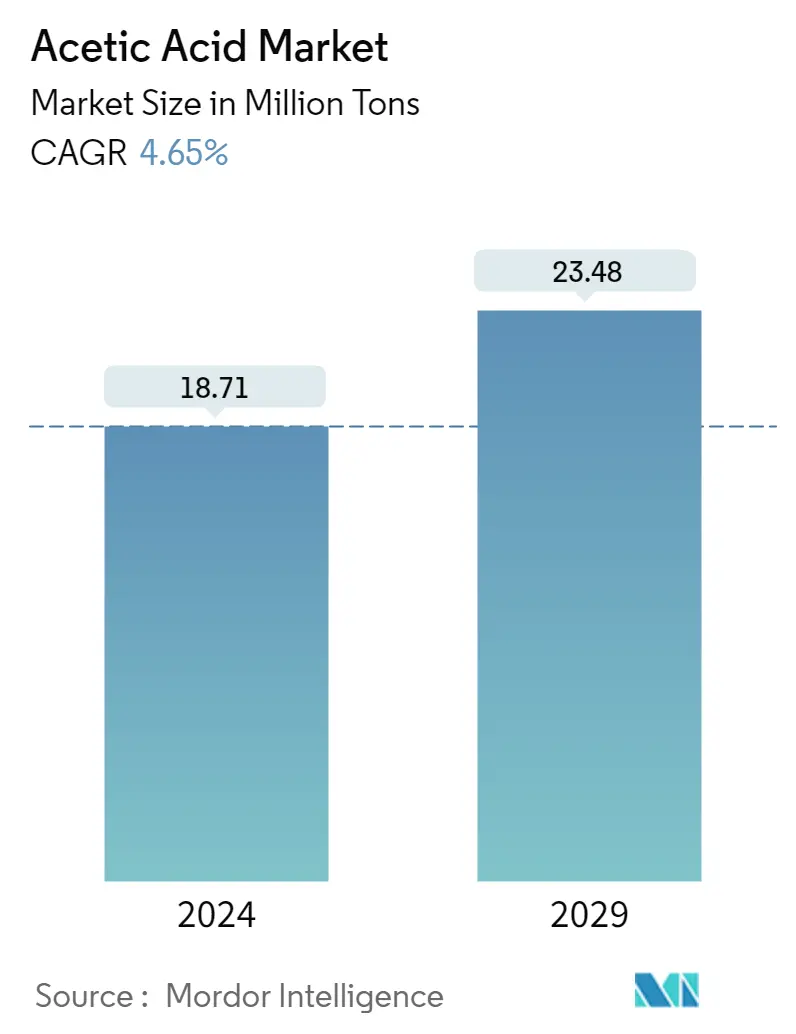
| Study Period | 2019 - 2029 |
| Base Year For Estimation | 2023 |
| CAGR (2024 - 2029) | 4.65 % |
| Fastest Growing Market | Asia-Pacific |
| Largest Market | Asia-Pacific |
| Market Concentration | Medium |
Major Players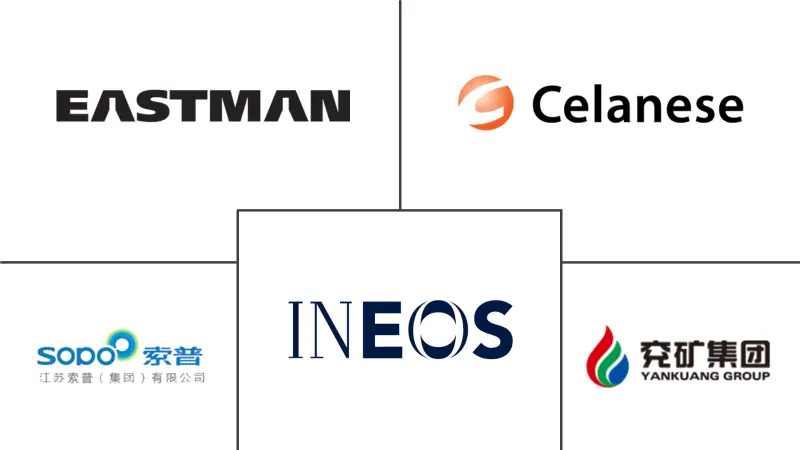
*Disclaimer: Major Players sorted in no particular order |
Acetic Acid Market Analysis
The Acetic Acid Market size is estimated at 18.71 Million tons in 2024, and is expected to reach 23.48 Million tons by 2029, growing at a CAGR of 4.65% during the forecast period (2024-2029).
The COVID-19 pandemic negatively impacted the market in 2020, owing to several restrictions imposed by governments all around the globe. However, the sector has been recovering well since restrictions were lifted. The market recovered significantly in the 2021-22 period, owing to rising consumption from various end-user industries, and is projected to continue doing so.
- Over the short term, the increasing demand for vinyl acetate monomer (VAM), the increasing demand from the textile and packaging industries, and the growing use of ester solvents in the paints and coatings industry are driving the growth of the acetic acid market.
- On the contrary, environmental concerns regarding the harmful effects of acetic acid are hindering the growth of the market.
- The development of new separation technologies to increase the production efficiency of acetic acid is expected to create opportunities for the market during the forecast period.
- The Asia-Pacific region is expected to dominate the market. It is also expected to register the highest CAGR during the forecast period.
Acetic Acid Market Trends
Increasing Applications in the Adhesives, Paints, and Coatings Industry
- Acetic acid, as well as its ester derivatives, such as ethyl acetate, butyl acetate, and vinyl acetate, are widely used in making adhesives, paints, and coatings. The acidic nature of acetic acid and its ability to dissolve polar and nonpolar compounds make it a useful ingredient in adhesives, paints, and coatings.
- Vinyl acetate monomer (VAM) is used in producing water-based paints, adhesives, waterproofing coatings, and paper and paperboard coatings. PTA-based polyesters and polyamides are also used in hot-melt adhesives. PTA is even used in paints as a carrier.
- The World's Paint and Coatings Industry Association estimated that in 2022, global sales of paints and coatings exceeded USD 180 billion. At the same time, the paints and coatings industry is anticipated to register a CAGR of about 3% by 2027.
- The value of the North American market was 33.92 billion USD in 2022, while the value of the European market was 42.37 billion USD, according to the association's annual report. It was considered that each of these locations would grow independently due to an increase in residential renovation projects in Canada, Germany, and the United States.
- According to the American Coatings Association (Coatings Tech), the paint and coatings industry in the United States is expected to reach USD 28.06 billion by 2022. Similarly, in terms of volume, the paint and coatings industry is estimated to reach 1,416 million gallons by 2022. This is likely to enhance the demand for acetic acid from the paints and coatings sector in the country.
- There are numerous significant paint companies in Europe, which is home to the continent's four largest mainland economies: Germany, France, Italy, and Spain. Europe's largest market for paints and coatings is in Germany. It is home to over 300 coatings, paint, and printing ink production firms.
- The key firms in the paints and coatings sector were also included in the WPCIA report, along with their market shares. It was anticipated that Sherwin-Williams (USD 21.64 billion) dominated the market, followed by PPG Industries (USD 17.15 billion), AkzoNobel NV (USD 11.9 billion), and Nippon Paints (USD 9.95 billion).
- Owing to all these factors, the rising investments in different industries will increase the demand for adhesives, paints, and coatings from all around the world and thus positively influence the acetic acid market.
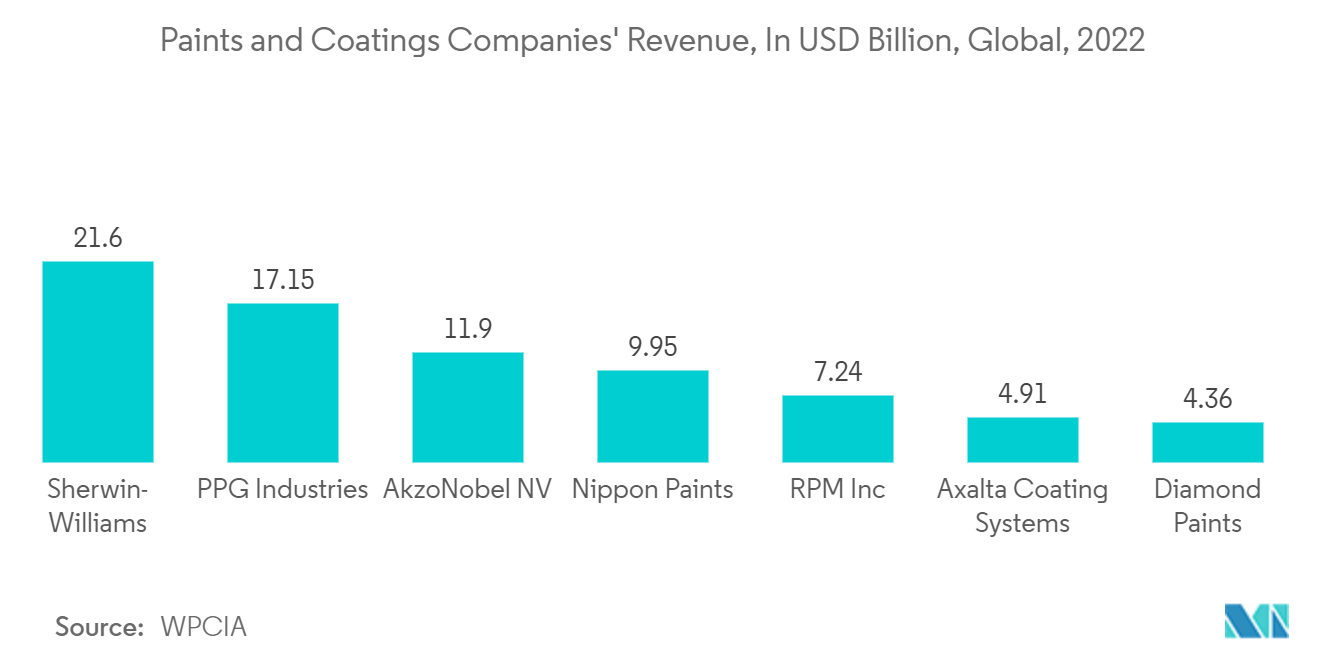
Asia-Pacific Region to Dominate the Market
- Asia-Pacific is the largest consumer of acetic acid in the global market. The Asia-Pacific market is anticipated to be the largest market for the adhesives, paints and coatings, food and beverage, and textile industries, owing to its strong industrial base.
- Acetic acid is widely used in greases, coatings, polyesters, and sealants, which have extensive applications in numerous industries, such as electronics, automobiles, textiles, and packaging. The extensive growth in these industries represents one of the major factors driving market growth in the Asia-Pacific region.
- The Asia-Pacific paints and coatings market was estimated to be worth USD 63 billion in 2022, according to the World's Paint and Coatings Industry Association. China dominates the region's market, which has been registering a CAGR of 5.8% over the last few years. In 2022, the Chinese market grew by 5.7%. According to current trends, China's total sales of paints and coatings exceeded USD 45 billion in 2022, giving the country a 78% market share in East Asia.
- According to European Coatings, there are nearly 10,000 coatings manufacturers located in China. Most of the leading global coating manufacturers, such as Nippon Paint, AkzoNobel, Chugoku Marine Paints, PPG Industries, BASF SE, and Axalta Coatings, have their manufacturing bases in China. Paint and coatings companies have been increasing their investments in the country. For instance, in July 2022, BASF expanded its production capacity of automotive refinish coatings in Guangdong Province in South China. The company has an annual capacity of 30,000 metric tons per year.
- According to the Ministry of Economy, Trade, and Industry (Japan), the production volume of synthetic resin paints in Japan amounted to approximately 1.01 million metric tons in 2021, making up an enormous production volume of paints. Overall, the production volume of paints added up to nearly 1.53 million metric tons in 2021, compared to 1.50 million metric tons in the prior year.
- Additionally, in January 2022, India's Ministry of Chemicals and Fertilizers published the quality control orders on acetic acid, aniline, morpholine, and methanol to postpone the implementation dates on them. It covers the specifications and standards of acetic acid production.
- According to the statistics presented by the Ministry of Chemicals and Fertilizers, in India, major chemical production climbed by 5.73% to 43.51 lakh metric tons in 2022-23 (up to July 2022), compared to 41.15 lakh metric tons in the previous year's similar period.
- With the growing global demand for various chemicals, the demand for intermediates, such as acetic acid, from this sector is expected to increase significantly during the forecast period.
- Due to the abovementioned factors, the market for acetic acid in the region is expected to have steady growth during the forecast period.
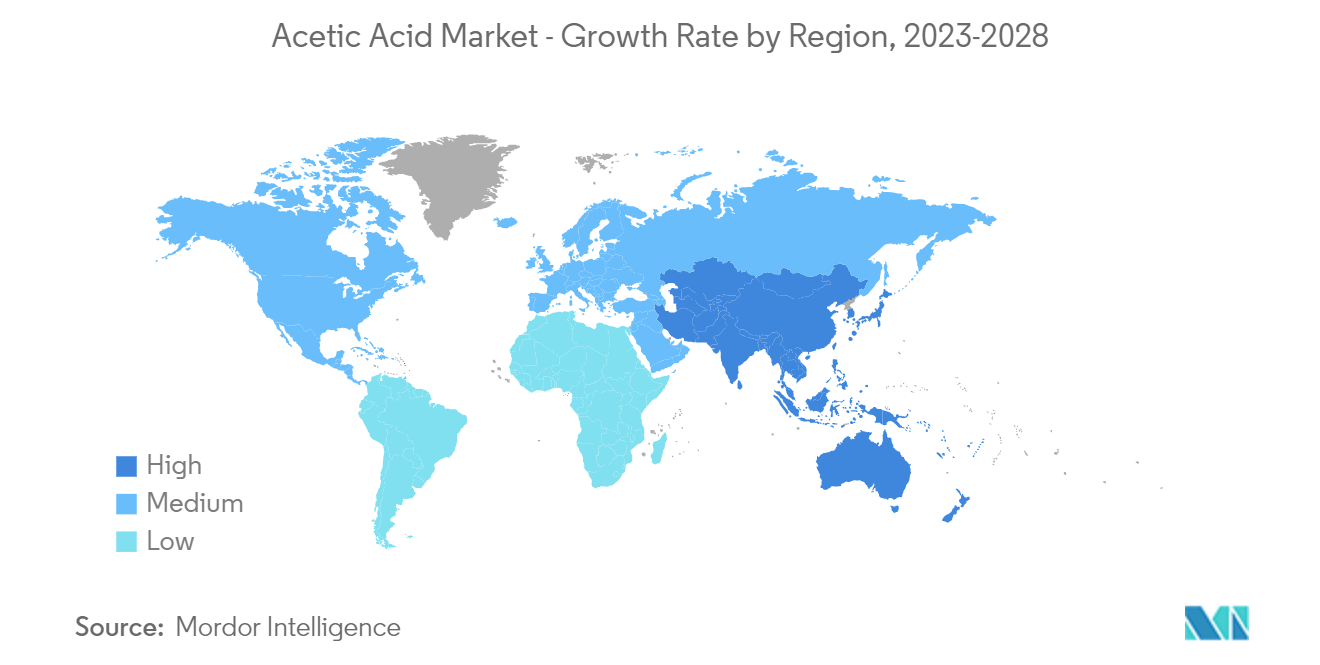
Acetic Acid Industry Overview
The acetic acid market is partially consolidated in nature. Some of the major players in the market include (not in any particular order) Celanese Corporation, INEOS, Jiangsu SOPO (Group) Co. Ltd, Yankuang Group, and Eastman Chemical Company, among others.
Acetic Acid Market Leaders
-
Celanese Corporation
-
INEOS
-
Jiangsu SOPO (Group) Co., Ltd.
-
Eastman Chemical Company
-
Yankuang Group
*Disclaimer: Major Players sorted in no particular order
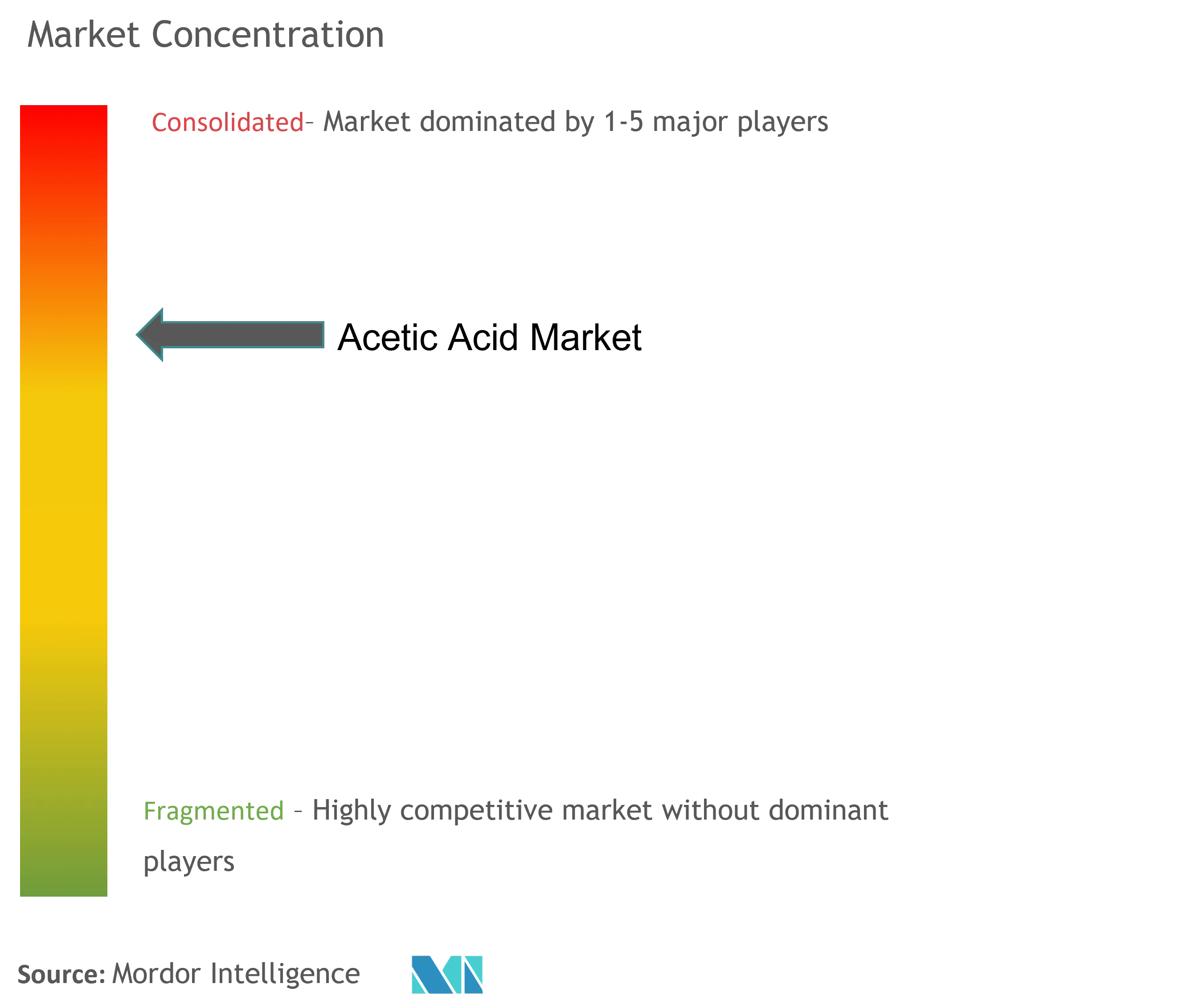
Acetic Acid Market News
- January 2023: Kingboard Holdings Limited announced that the company's unit, Hebei Kingboard Energy Development Co., Ltd., plans to submit the "Environmental Impact Report of Hebei Kingboard Energy Development Co., Ltd. Acetic Acid Expansion and Transformation Project" for approval, and the entire content of the environmental impact study is accessible.
- June 2022: Hebei Kingboard Energy Development Co., Ltd. announced the beginning of construction of an acetic acid facility with a capacity of 29,80 tons per year. The CNY 23.20 billion (USD 3.6 billion) project was based on a 35,20 tons/year carbon capture and recycling project to establish a high-value-added carbon neutrality demonstration park for innovative chemical materials and realize low-carbon development.
Acetic Acid Market Report - Table of Contents
1. INTRODUCTION
- 1.1 Study Assumptions
- 1.2 Scope of the Study
2. RESEARCH METHODOLOGY
3. EXECUTIVE SUMMARY
4. MARKET DYNAMICS
-
4.1 Drivers
- 4.1.1 Increasing Demand for Vinyl Acetate Monomer (VAM)
- 4.1.2 Increasing Demand from the Textile and Packaging Industry
- 4.1.3 Increasing Use of Ester Solvents in the Paints and Coating Industry
-
4.2 Restraints
- 4.2.1 Environmental Concerns Regarding the Harmful Effects
- 4.3 Industry Value Chain Analysis
-
4.4 Porter's Five Forces Analysis
- 4.4.1 Bargaining Power of Suppliers
- 4.4.2 Bargaining Power of Buyers
- 4.4.3 Threat of New Entrants
- 4.4.4 Threat of Substitute Products and Services
- 4.4.5 Degree of Competition
5. MARKET SEGMENTATION (Market Size in Volume)
-
5.1 Derivative
- 5.1.1 Vinyl Acetate Monomer (VAM)
- 5.1.2 Purified Terephthalic Acid (PTA)
- 5.1.3 Ethyl Acetate
- 5.1.4 Acetic Anhydride
- 5.1.5 Other Derivatives
-
5.2 Application
- 5.2.1 Plastics and Polymers
- 5.2.2 Food and Beverage
- 5.2.3 Adhesives, Paints, and Coatings
- 5.2.4 Textile
- 5.2.5 Medical
- 5.2.6 Other Applications
-
5.3 Geography
- 5.3.1 Asia-Pacific
- 5.3.1.1 China
- 5.3.1.2 India
- 5.3.1.3 Japan
- 5.3.1.4 South Korea
- 5.3.1.5 Rest of Asia-Pacific
- 5.3.2 North America
- 5.3.2.1 United States
- 5.3.2.2 Canada
- 5.3.2.3 Mexico
- 5.3.3 Europe
- 5.3.3.1 Germany
- 5.3.3.2 United Kingdom
- 5.3.3.3 Italy
- 5.3.3.4 France
- 5.3.3.5 Rest of Europe
- 5.3.4 South America
- 5.3.4.1 Brazil
- 5.3.4.2 Argentina
- 5.3.4.3 Rest of South America
- 5.3.5 Middle East and Africa
- 5.3.5.1 Saudi Arabia
- 5.3.5.2 South Africa
- 5.3.5.3 Rest of Middle East and Africa
6. COMPETITIVE LANDSCAPE
- 6.1 Mergers and Acquisitions, Joint Ventures, Collaborations, and Agreements
- 6.2 Market Share Analysis
- 6.3 Strategies Adopted by Leading Players
-
6.4 Company Profiles
- 6.4.1 Celanese Corporation
- 6.4.2 Chang Chun Group
- 6.4.3 Daicel Corporation
- 6.4.4 Eastman Chemical Company
- 6.4.5 GNFC Limited
- 6.4.6 INEOS
- 6.4.7 Jiangsu SOPO (Group) Co. Ltd.
- 6.4.8 Kingboard Holdings Limited
- 6.4.9 LyondellBasell Industries Holdings BV
- 6.4.10 Mitsubishi Chemical Corporation
- 6.4.11 PetroChina Company Limited
- 6.4.12 Sabic
- 6.4.13 Shandong Hualu-Hengsheng Chemical Co. Ltd.
- 6.4.14 Shanghai Huayi Holding Group Co. Ltd.
- 6.4.15 Sipchem Company
- 6.4.16 Svensk Etanolkemi AB (SEKAB)
- 6.4.17 Tanfac Industries Ltd.
- 6.4.18 Yankuang Group
- *List Not Exhaustive
7. MARKET OPPORTUNITIES AND FUTURE TRENDS
- 7.1 Development of New Separation Technologies to Increase the Production Efficiency
Acetic Acid Industry Segmentation
Acetic acid is a monocarboxylic acid containing two carbons. It is a clear, colorless liquid with a strong, pungent odor, like vinegar. Acetic acid can be derived from the carbonylation of methanol, the oxidation of acetaldehyde and ethylene, or a biological method like bacterial fermentation. It is used as a chemical reagent to produce several chemical compounds like acetic anhydride, ester, vinyl acetate monomer, vinegar, and many other polymeric materials. The acetic acid market is segmented by derivative, application, and geography. By derivative, the market is segmented into vinyl acetate monomer (VAM), purified terephthalic acid (PTA), ethyl acetate, acetic anhydride, and other derivatives. By application, the market is segmented into plastics and polymers, food and beverage, adhesives, paints and coatings, textiles, medical, and other applications. By geography, the market is segmented into Asia-Pacific, North America, Europe, South America, and the Middle East and Africa. The report also covers the market size and forecasts for the acetic acid market in 15 countries across major regions. For each segment, the market sizing and forecasts have been done in terms of volume in kilotons.
| Derivative | Vinyl Acetate Monomer (VAM) | |
| Purified Terephthalic Acid (PTA) | ||
| Ethyl Acetate | ||
| Acetic Anhydride | ||
| Other Derivatives | ||
| Application | Plastics and Polymers | |
| Food and Beverage | ||
| Adhesives, Paints, and Coatings | ||
| Textile | ||
| Medical | ||
| Other Applications | ||
| Geography | Asia-Pacific | China |
| India | ||
| Japan | ||
| South Korea | ||
| Rest of Asia-Pacific | ||
| Geography | North America | United States |
| Canada | ||
| Mexico | ||
| Geography | Europe | Germany |
| United Kingdom | ||
| Italy | ||
| France | ||
| Rest of Europe | ||
| Geography | South America | Brazil |
| Argentina | ||
| Rest of South America | ||
| Geography | Middle East and Africa | Saudi Arabia |
| South Africa | ||
| Rest of Middle East and Africa |
Acetic Acid Market Research FAQs
How big is the Acetic Acid Market?
The Acetic Acid Market size is expected to reach 18.71 million tons in 2024 and grow at a CAGR of 4.65% to reach 23.48 million tons by 2029.
What is the current Acetic Acid Market size?
In 2024, the Acetic Acid Market size is expected to reach 18.71 million tons.
Who are the key players in Acetic Acid Market?
Celanese Corporation, INEOS, Jiangsu SOPO (Group) Co., Ltd., Eastman Chemical Company and Yankuang Group are the major companies operating in the Acetic Acid Market.
Which is the fastest growing region in Acetic Acid Market?
Asia-Pacific is estimated to grow at the highest CAGR over the forecast period (2024-2029).
Which region has the biggest share in Acetic Acid Market?
In 2024, the Asia-Pacific accounts for the largest market share in Acetic Acid Market.
What years does this Acetic Acid Market cover, and what was the market size in 2023?
In 2023, the Acetic Acid Market size was estimated at 17.88 million tons. The report covers the Acetic Acid Market historical market size for years: 2019, 2020, 2021, 2022 and 2023. The report also forecasts the Acetic Acid Market size for years: 2024, 2025, 2026, 2027, 2028 and 2029.
Which segment accounted for the largest Acetic Acid Market Share?
The Adhesives, Paints, and Coatings segment accounted for the largest Acetic Acid Market Share.
What are the driving factors of the Acetic Acid Market?
The driving factors of the Acetic Acid Market are a) The rapid expansion of the textile and cosmetics industry b) Rise in demand for food products c) Increasing Demand for Vinyl Acetate Monomer (VAM)
Acetic Acid Industry Report
The global acetic acid market is witnessing significant growth, fueled by its extensive use in industries like plastics, textiles, food & beverage, and chemicals. This surge is primarily due to the rising demand for key components such as vinyl acetate monomer (VAM), acetic anhydride, acetate esters, and purified terephthalic acid, vital for manufacturing paints, coatings, adhesives, and polyester fibers. Acetic acid producers are optimizing production techniques to cater to these expanding market segments. The Asia-Pacific region leads the market, driven by rapid industrialization and increasing demand in construction, pharmaceuticals, automotive, and textiles. North America, particularly the U.S., also exhibits significant consumption, especially in the food & beverage sector, where the "food-grade" quality of acetic acid is crucial. The competitive landscape features multinational corporations focusing on research, development, and strategic initiatives like expansions and collaborations to bolster their market position and address the global acetic acid demand. With a comprehensive market forecast outlook and historical overview provided by Mordor Intelligence™ Industry Reports, stakeholders can access a detailed analysis of the acetic acid market's share, size, and revenue growth rate, available as a free report PDF download, highlighting the market's path to continued growth and adaptation to evolving industrial demands.



